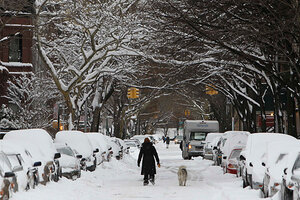Holiday sales 2009: how the East Coast snowstorm helped
Data released Monday show that online holiday sales skyrocketed – probably because many people on the East Coast stayed home to shop on a snowy ‘Super Saturday.’

Snow covers a street in Brooklyn, New York on December 20.
Brendan McDermid/Reuters
Chicago
The storm that hammered the East Coast on the last shopping weekend before Christmas was a boon for online shopping.
That’s one of the findings in data released by MasterCard Advisors’ SpendingPulse Monday – the first glimpse at the 2009 holiday shopping season. SpendingPulse, which analyzes national retail and service sales, reported that 6 of the 10 retail sectors it tracks showed positive growth between Nov. 1 and Dec. 24.
The greatest gains came from online commerce, which enjoyed a 15.5 percent increase during the past two months. After “Black Friday,” the day after Thanksgiving that retailers use to kick-off special sales and promotions, sales increased 18 percent.
The overall trend helped avoid last year’s poor holiday sales, which declined 3.4 percent from 2007 to a historic low. Various media reports suggest that sales increased 3.6 percent in November and December, but SpendingPulse could not confirm the number.
The 'Super Saturday' snowstorm
Retailers had worried that the snowstorm that hit on “Super Saturday” – considered the second heaviest holiday shopping day after “Black Friday" – would hurt their sales. But the storm likely pushed sales “to online shopping and acted like a big shock absorber,” which may also have pushed brick-and-mortar sales to late in the week, says Kamalesh Rao, director of economic research at MasterCard SpendingPulse.
“The storm created a last-minute surge; it delayed shopping that weekend,” he says, adding that the unstable weather conditions illustrated to retailers the value of catering to online shoppers.
Seasonal sales growth in other retail sectors was much more modest, ranging from 0.8 percent (luxury retail) to 5.9 percent (electronics).
The increases are not a result of price wars. The majority of retailers refused to knock down prices as dramatically as they did last year, when price reductions averaged 15 percent. Thinning inventory from last year meant “they didn’t need to price cut this year,” Mr. Rao adds.
Sales also may have benefited from an extra shopping day this year; Christmas fell on a Thursday in 2008.
Data 'as good as you can expect'
Although results “are a bit more positive” than last year, last season’s sales “had shrunk so low, any sort of growth is pretty decent,” Rao says.
This year’s numbers do not signal that an immediate recovery is underway, he adds. “These numbers are as probably good as you can expect given the economic climb we are in,” he says. “The key number here that continues to weigh on sales is unemployment.”
ShoppingPulse is one of several companies that track holiday sales. Others, including the National Retail Federation, the International Council of Shopping Centers, and ShopperTrak have yet to come out with their post-holiday figures.
Retailers no doubt relish the positive numbers, hoping they point to an economic turnaround. But consumers are still wary. In a late December poll by CNN/Opinion Research Corp., the greatest share of respondents – 42 percent – said the economic conditions in the country today are “very poor.”
Many economists consider optimism a key factor in getting consumers shopping.
-----
Follow us on Twitter.
